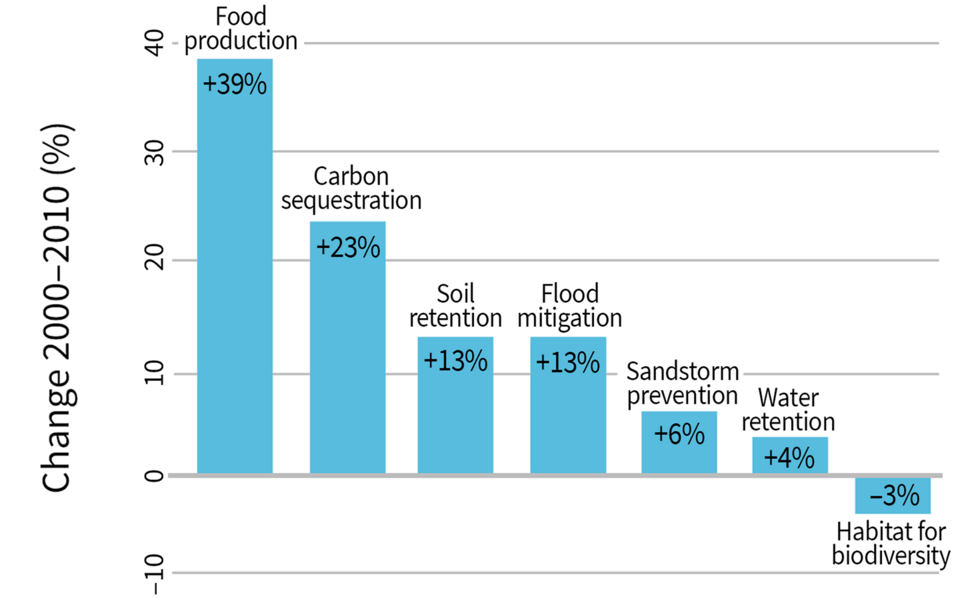Greening of the People’s Republic: China’s Investment in Conservation
Greening of the People’s Republic: China’s Investment in Conservation [ 4 min read ]
Insights
- China is carrying out among the most ambitious and far-reaching ecological conservation regimens ever implemented in the world.
- According to a new model that assigns value to natural resources based on their importance to human livelihoods, China's efforts have driven marked improvements across almost all evaluated measures.
- China’s success suggests that conservation policies can facilitate economic growth.
Source Publication: Ouyang Zhiyun, Zheng Hua, Gretchen C. Daily, et al. (2016). Improvements in Ecosystem Services from Investments in Natural Capital.Science.
Analyzing China’s ecological conservation policies is important for understanding how it is managing decades of ecological damage caused by rapid economic development. Half of China’s land is under some form of conservation, but only scattered case studies exist to ascertain their effectiveness. Using a new model that assigns value to “ecosystem services,” defined as benefits that the natural environment and healthy ecosystems supply to people, this study assesses for the first time the impact of China’s conservation policies on ecological preservation and human livelihoods.
The data. Using a unique and expansive dataset gathered between 2000–2010 that includes more than 20,000 satellite images and over 100,000 field surveys, along with other key ecological health measures, the analysis measures the impact of China’s conservation policies on a range of ecosystem services including food production, carbon sequestration, soil retention, sandstorm prevention, water retention, flood mitigation, and habitat provision for biodiversity.
Major gains in ecosystem services. The analysis finds that significant improvements have occurred across almost all evaluated measures, largely due to intensive ecosystem restoration. China’s food production, quantified by the amount of calories a unit of land can produce, increased by 39%. Carbon sequestration increased by 23% due to increased forest, grassland, and wetlands coverage. Soil retention rose by 13%, flood mitigation by 13%, sandstorm prevention by 6%, and water retention by 4%. Conversely, habitat provision for biodiversity, as measured by the total habitat area of endemic, endangered, and nationally protected species per county, decreased by 3%.
Improvements across almost all evaluated measures

Gains varied significantly by region. Certain regions designated as important for securing ecosystem services experienced striking improvements, while other areas experienced decreases across evaluated measures. To illustrate this point, though they made up only 37% of China’s area, priority conservation areas realized 83% of the total gains in carbon sequestration, 78% in soil retention, 59% in sandstorm prevention, 80% in water retention, and encompassed 56% of its natural habitats.
Map of China shows spatial patterns of significant improvements in ecosystem services provision

In particular, three priority areas that had been degraded because of unsustainable human activity have realized marked improvements as a result of conservation policies. Sanjiangyuan is the “water tower” of Asia, containing the headwaters of the Yellow, Yangtze, and Mekong Rivers. The Loess Plateau is the most sensitive area to soil erosion in the world. The Taihang Mountains are the ecological shelter for northern China, including Beijing, Tianjin, and the North China Plain.
Conservation supporting economic development. China is carrying out among the world’s most ambitious conservation regimens ever implemented. A first-of-its-kind analysis has shown that China’s efforts to conserve ecosystem services have been mostly effective, particularly in areas where these resources are most valuable for human welfare. While several key challenges, including securing water and air quality, lie outside the scope of the current analysis, the gains accrued through China’s conservation efforts suggest that conservation does not hinder, and indeed can fundamentally support the development process.
